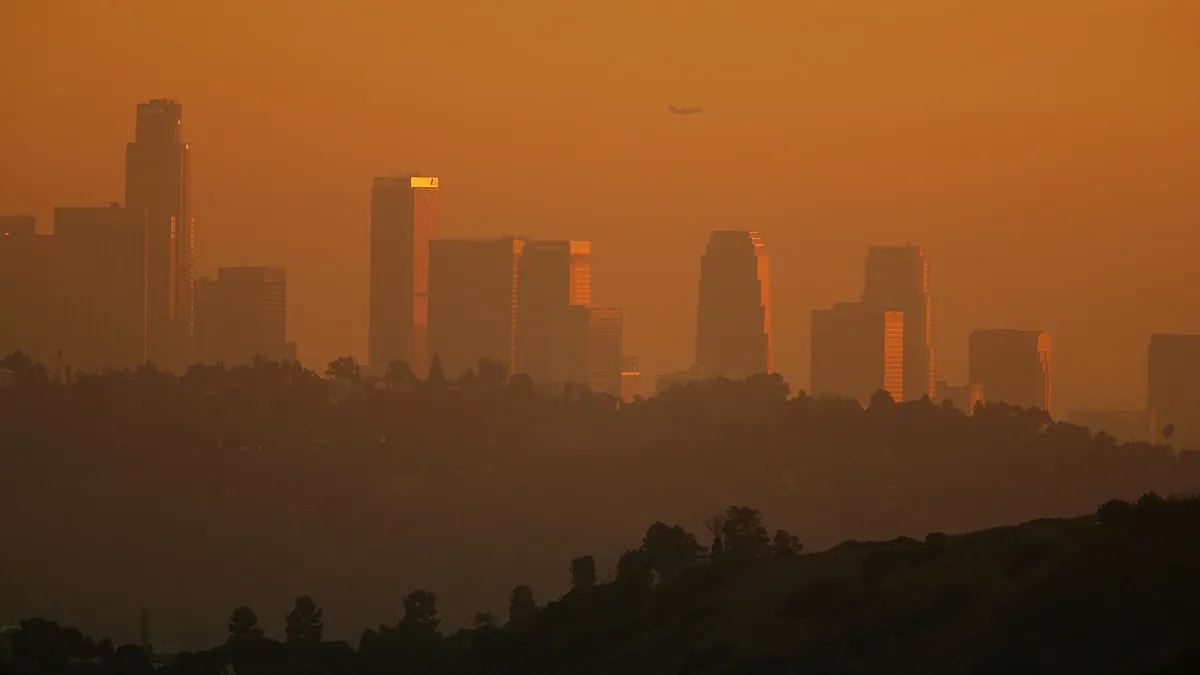Dive Brief:
- The number of people exposed to short-term particle pollution, one measure of unhealthy air quality, hit a 10-year high in the American Lung Association’s 24th annual “State of the Air” report, released Wednesday. Nearly 64 million residents lived in counties with a failing grade for daily spikes in particulate matter from 2019 to 2021, more than in any of the previous 10 reports, it says.
- The difference in air quality between Western and Eastern states is growing as the Clean Air Act has driven emissions reductions from transportation, manufacturing and power plants in the East but climate change contributes to heat, drought and wildfires that exacerbate air pollution in the West, the report says.
- To improve local air quality, the report recommends local governments purchase zero-emission fleet vehicles; power city and county operations with non-combustion, renewable energy; and adopt a climate action plan that supports walking, biking, transit and zero-emission vehicle infrastructure.
Dive Insight:
Since 2000, the American Lung Association’s “State of the Air” report has examined air pollution in communities nationwide, first looking solely at ozone, which at ground level is the main ingredient in smog, and in 2004 adding particle pollution, including dust and smoke. This year’s report is based on 2019-2021 data from the U.S. Environmental Protection Agency’s Air Quality System.
Although 23 of the 25 cities with the worst daily particle pollution were in the West, the cities with the worst year-round particle pollution were all over the country. These cities, such as Detroit and Pittsburgh, have high power plant emissions and local industrial and mobile pollution sources, the report says.
Bakersfield, California, which is north of Los Angeles, was the most polluted city for daily particle pollution and tied for most year-round particle pollution with Visalia, California, situated in the San Joaquin Valley.
This year’s report shows falling ozone levels nationwide, which it attributes to emissions controls and, particularly in the Eastern U.S., the economy’s transition away from coal.
The report named Los Angeles the U.S. city with the worst ozone pollution, which may not come as a surprise considering it has held that position every year but one since the first State of the Air report.
Climate change is complicating Western communities’ efforts to address ozone pollution, the report says, because it contributes to weather conditions associated with higher ozone levels, such as higher temperatures; dry, sunny skies; and more frequent air stagnation.
“Simply, climate change is undercutting the progress we would have made,” the report says.
People of color were more than 3.7 times as likely as White people to live in a county with failing grades for daily particle pollution, year-round particle pollution and ozone pollution, the report says.
In addition to taking the steps recommended in the report, local governments could protect people’s health during wildfires by teaching them how to monitor and respond to unhealthy air quality, said Liz Scott, the American Lung Association’s national director, advocacy, healthy air, in an interview. She also said local governments could establish community centers with air filtration systems and ensure people have access to protective equipment such as N95 masks.
The report also highlights the seven “cleanest” cities, which had zero days of high particle pollution or ozone and are among the 25 cities with the lowest year-round particle pollution:
- Ashville-Marion-Brevard, North Carolina
- Bangor, Maine
- Greenville-Kinston-Washington, North Carolina
- Lincoln-Beatrice, Nebraska
- Rochester-Batavia-Seneca Falls, New York
- Urban Honolulu, Hawaii
- Wilmington, North Carolina












